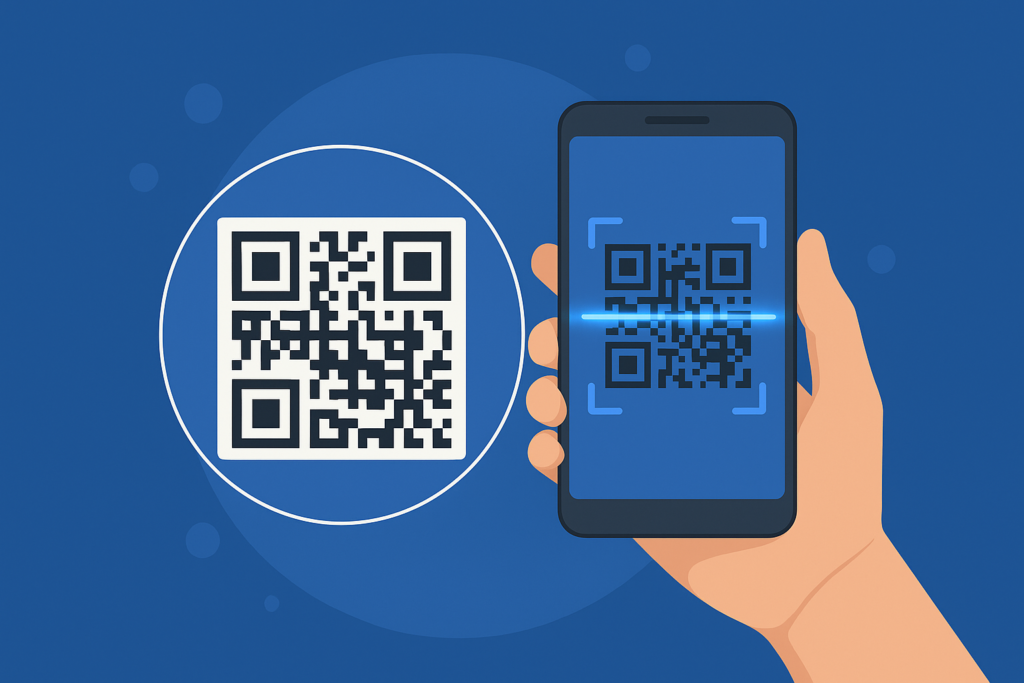A QR code stores data in a two-dimensional format that any smartphone can scan. Once the camera reads it, users connect instantly to websites, payments, or interactive campaigns. This simplicity is precisely why QR codes have become central to marketing, finance, and customer engagement—they transform fleeting attention into measurable, trackable interactions.
What is a QR Code?
QR stands for “Quick Response,” a name that reflects the original design philosophy: high-speed, frictionless scanning.
Technically, a QR code is a two-dimensional barcode capable of storing links, text, contact information, or encrypted data. Importantly, any modern smartphone camera can read and process it without requiring special applications—though dedicated apps enhance security and speed.
The technology itself is straightforward yet powerful: a grid of black and white squares encodes information that devices interpret instantly.
Example: When scanned, a QR code might redirect users to VISU Network to unlock promotions or rewards—connecting the physical world to digital engagement in seconds.
The Origin Story: From Manufacturing to Everywhere
QR codes were invented in 1994 by Masahiro Hara and his team at Denso Wave, a Japanese automotive company. Originally, they were designed to track parts during car manufacturing—a purely internal logistics tool.
The breakthrough came from an unexpected place. Hara drew inspiration from the game Go, where black and white stones create a grid pattern. This insight shaped the QR code’s distinctive square design. Over three decades, what began as a manufacturing solution evolved into one of the most ubiquitous technologies worldwide.
The pandemic accelerated adoption dramatically. Restaurants switched to digital menus, events went contactless, and payment systems went digital—all relying on QR codes as the bridge between physical and digital worlds.
How QR Codes Work: The Technical Process
Understanding the mechanics helps explain why QR codes are so effective.
Step 1: Digital Generation A QR code is created with embedded information—a URL, payment details, contact data, or any other encoded content. The generator creates a unique pattern of black and white squares based on this data.
Step 2: Camera Detection The smartphone camera detects the QR code’s pixel pattern. Importantly, the three corner markers help the phone identify and orient the code correctly, even if it’s at an angle or partially obscured.
Step 3: Data Interpretation The reader app decodes the pattern and translates it into actionable information—typically a URL or command.
Step 4: Instant Access Within milliseconds, the user is redirected to the intended destination. Whether it’s a website, payment page, or app function, no typing is required.
Step 5: Engagement Tracking Behind the scenes, analytics systems record the scan: time, location, device type, and whether the user completed a desired action (purchase, signup, etc.).
This entire process happens in seconds, which is why QR codes feel seamless.
Static QR Codes vs. Dynamic QR Codes
Understanding the difference is important for business applications.
Static QR codes contain fixed information that doesn’t change once generated. They’re ideal for small businesses, street vendors, or permanent payment addresses. Since the destination is fixed, they can’t be updated.
Dynamic QR codes are generated fresh for each transaction or campaign, containing real-time details like specific amounts, unique invoice IDs, or personalized content. These are preferred for retail, restaurants, and enterprises because they offer superior security, enhanced tracking, and the ability to be edited after printing.
For marketing campaigns, dynamic codes are almost always superior because they enable A/B testing, real-time optimization, and detailed performance analytics.
QR Codes in Marketing Campaigns
Modern marketing has embraced QR codes as a core engagement channel.
Brands increasingly deploy QR codes in bars, restaurants, live events, and retail spaces. Consequently, customers scan and immediately receive discounts, exclusive gifts, or special access. Moreover, this simple interaction boosts engagement while providing companies with valuable data for optimization and personalization.
Consider the typical flow: a customer sees a promotional QR code on packaging, scans it with their phone, and unlocks a limited-time offer. The system simultaneously tracks the scan’s location, time, and device type—insights that inform future campaigns.
This approach proves especially effective because it removes friction. Traditional promotions require customers to remember codes, visit websites, or fill out forms. QR codes compress that entire journey into a single action.
Payments and Finance Applications
QR code payments have become infrastructure in major economies.
In Brazil, Pix has become the dominant QR-based payment solution, processing millions of transactions daily. Similarly, China’s QR code payment systems facilitate billions of transactions every day through platforms like Alipay and WeChat Pay. Therefore, this model proves both economical and highly accessible compared to traditional card infrastructure.
The financial advantage is significant: merchants don’t need expensive point-of-sale terminals, just a smartphone camera. This democratizes payment acceptance, especially in developing markets where banking infrastructure is limited.
Gamification and User Experience
Scanning has evolved beyond simple redirects into interactive experiences where brands offer rewards, exclusive content, or loyalty points.
This transformation is strategic. Rather than treating QR codes as passive links, forward-thinking companies integrate them into gamified campaigns. Users accumulate points for each scan, unlock levels, or compete for prizes. Consequently, this approach drives repeat engagement and builds emotional connection to the brand.
The psychology is sound: gamification taps into intrinsic motivation, transforming mundane transactions into moments of delight. A customer doesn’t just scan a code—they earn something, discover something, or accomplish something.
Real-Life Examples of How QR Codes Work
Restaurants and Digital Menus After the pandemic, digital menus became standard. Customers scan a QR code at the table, see the full menu with photos and descriptions, order, and pay—all from one device. Restaurants benefit from reduced printing costs and the ability to update menus instantly.
Event Ticketing Events use QR codes for admission and engagement. Attendees scan to enter, then scan additional codes throughout the event to unlock sponsor content, enter contests, or access exclusive areas. This creates engagement data that event organizers and sponsors can analyze.
Retail Loyalty Programs Retail chains embed QR codes in receipts or on-shelf displays. Customers scan to join loyalty programs, claim rewards, or access personalized offers. Each scan strengthens the customer relationship and provides retailers with purchase behavior insights.
Startups and Attention Monetization Newer platforms reward users for scanning—converting attention into measurable value. Users earn digital currency or real rewards by engaging with branded content, creating a new economy around attention.
Why QR Codes Are So Effective
Low implementation cost Creating and printing QR codes is inexpensive compared to other digital marketing tools. Businesses can launch campaigns immediately without major infrastructure investment.
Universal accessibility Since any smartphone camera reads QR codes, adoption barriers are minimal. No special apps, compatibility issues, or device limitations.
Real-time tracking Unlike traditional print media, every scan generates data. Marketers know precisely when people engaged, from where, and sometimes whether they completed desired actions.
Scalability The system works identically for a small local business and a multinational corporation. One code on a food truck functions exactly like codes across thousands of retail locations.
Measurable engagement QR codes transform anonymous interactions into trackable, attributable events. This enables data-driven optimization and precise ROI calculation.
Cross-channel integration QR codes integrate seamlessly with email, social media, physical displays, and digital advertising. They’re connective tissue between offline and online.
Turn Every QR Scan Into a Trackable Touchpoint
VISU connects each QR code to dynamic pages, rewards, and real-time analytics — so you can see exactly how every scan impacts visits, revenue, and loyalty.
Conclusion
Now you understand how QR codes work and why this technology has become central to marketing, payments, and user engagement. Importantly, their affordability combined with universal accessibility makes them attractive for businesses of all sizes—from bootstrapped startups to global brands.
The mechanics are simple, but the applications are limitless. Whether you’re building customer loyalty, processing payments, distributing digital content, or creating engaging campaigns, QR codes provide the bridge between attention and action.
As technology continues evolving, QR codes will remain fundamental infrastructure because they solve a persistent problem: connecting the physical world to digital experiences with zero friction.

FAQ: How QR Codes Work
How does a QR code actually work?
Do all smartphones scan QR codes natively?
What is the difference between static and dynamic QR codes?
Are QR codes themselves secure?
How can businesses track QR code performance?

